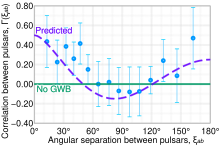User:Zinn-24/sandbox
Hellings-Downs curve[edit]

The Hellings-Downs curve (also known as the Hellings and Downs curve) is an analytical tool that helps to find patterns in pulsar timing data in an effort to detect long wavelength gravitational waves.[2][3] More precisely, the Hellings-Downs curve refers to the wave-like shape predicted to appear in a plot of timing residual correlations versus the angle of separation between pairs of pulsars. This theoretical correlation function assumes a gravitational wave background that is isotropic and Einsteinian.[4]
Pulsar timing array residuals[edit]
Albert Einstein’s theory of general relativity predicts that a mass will deform spacetime causing gravitational waves to emanate outward from the source. These gravitational waves will affect the travel time of any light that interacts with them. A pulsar timing residual is the difference between the expected time of arrival and the observed time of arrival of light from pulsars. Because pulsars flash with such a consistent rhythm, it is hypothesised that if a gravitational wave is present, a pattern may be observed in the changing arrival times of these pulsar emissions. Pulsar timing residuals are measured using pulsar timing arrays.
History[edit]
After discovering the first millisecond pulsar in 1982, Donald Backer realised that the consistent flashes from these pulsars could be used to detect gravitational waves.[5] Building on this concept, the following year Ron Hellings and George Downs published the foundations of the Hellings-Downs curve in their 1983 paper “Upper Limits on the Isotropic Gravitational Radiation Background from Pulsar Timing Analysis”[4]. Donald Backer would later go on to become one of the founders of NANOGrav, a research team that regularly uses the Hellings-Downs curve in their investigations.[1][6]
Examples in the scientific literature[edit]
In 2023, using pulsar timing array data collected over 15 years, the North American Nanohertz Observatory for Gravitational Waves (NANOGrav) published their latest evidence for the existence of a gravitational wave background. The Hellings and Downs curve has featured prominently in NANOGrav’s search for an isotropic stochastic gravitational wave background. (Put in HD plot from NANOGrav)
A total of 2,211 millisecond pulsar pair combinations were used by the NANOGrav team, derived from long-term timing of flashes from 67 millisecond pulsars. The NANOGrav 15 year collaboration wrote that “The observation of Hellings–Downs correlations points to the gravitational-wave origin of this signal.”[7] This highlights the important role that the Hellings-Downs curve plays in contemporary gravitational wave research.
Equation of the Hellings and Downs curve[edit]
Reardon et al. (2023) from the Parkes pulsar timing array team give the following equation for the Hellings and Downs curve:[8]
Where , is the kronecker delta function, representing the angle of separation between the two pulsars, as seen from earth, and is the angular correlation function. This curve assumes an isotropic gravitational wave background from a supermassive black hole binary system.
References[edit]
- ^ a b "Evidence for a Gravitational-Wave Background | NANOGrav". nanograv.org. Retrieved 2024-02-18.
- ^ Jenet, Fredrick A.; Romano, Joseph D. (2015-07-01). "Understanding the gravitational-wave Hellings and Downs curve for pulsar timing arrays in terms of sound and electromagnetic waves". American Journal of Physics. 83 (7): 635–645. doi:10.1119/1.4916358. ISSN 0002-9505.
- ^ Agazie, Gabriella; Anumarlapudi, Akash; Archibald, Anne M.; Arzoumanian, Zaven; Baker, Paul T.; Bécsy, Bence; Blecha, Laura; Brazier, Adam; Brook, Paul R.; Burke-Spolaor, Sarah; Burnette, Rand; Case, Robin; Charisi, Maria; Chatterjee, Shami; Chatziioannou, Katerina (2023-07-01). "The NANOGrav 15 yr Data Set: Evidence for a Gravitational-wave Background". The Astrophysical Journal Letters. 951 (1): L8. doi:10.3847/2041-8213/acdac6. ISSN 2041-8205.
{{cite journal}}: CS1 maint: unflagged free DOI (link) - ^ a b Hellings, R. W.; Downs, G. S. (1983-02-01). "Upper limits on the isotropic gravitational radiation background from pulsar timing analysis". The Astrophysical Journal. 265: L39. doi:10.1086/183954. ISSN 0004-637X.
- ^ "After 15 years, pulsar timing yields evidence of cosmic gravitational wave background". Berkeley. 2022. Retrieved 2024-02-18.
- ^ "North American Nanohertz Observatory for Gravitational Waves", Wikipedia, 2024-01-22, retrieved 2024-02-18
- ^ Agazie, Gabriella; Anumarlapudi, Akash; Archibald, Anne M.; Arzoumanian, Zaven; Baker, Paul T.; Bécsy, Bence; Blecha, Laura; Brazier, Adam; Brook, Paul R.; Burke-Spolaor, Sarah; Burnette, Rand; Case, Robin; Charisi, Maria; Chatterjee, Shami; Chatziioannou, Katerina (2023-07-01). "The NANOGrav 15 yr Data Set: Evidence for a Gravitational-wave Background". The Astrophysical Journal Letters. 951 (1): L8. doi:10.3847/2041-8213/acdac6. ISSN 2041-8205.
{{cite journal}}: CS1 maint: unflagged free DOI (link) - ^ Reardon, Daniel J.; Zic, Andrew; Shannon, Ryan M.; Hobbs, George B.; Bailes, Matthew; Di Marco, Valentina; Kapur, Agastya; Rogers, Axl F.; Thrane, Eric; Askew, Jacob; Bhat, N. D. Ramesh; Cameron, Andrew; Curyło, Małgorzata; Coles, William A.; Dai, Shi (2023-07-01). "Search for an Isotropic Gravitational-wave Background with the Parkes Pulsar Timing Array". The Astrophysical Journal Letters. 951 (1): L6. doi:10.3847/2041-8213/acdd02. ISSN 2041-8205.
{{cite journal}}: CS1 maint: unflagged free DOI (link)







